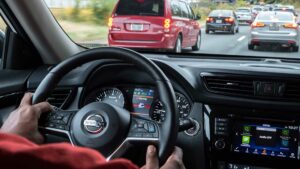
JD Power says new vehicles are becoming ‘more problematic’
By onMarket Trends | Technology
New vehicles are continuing to decline in quality as automakers lean into complicated technologies and continue to integrate “known problematic” features into models, JD Power said in a new report.
According to its newly-released 2023 U.S. Initial Quality StudySM (IQS), problems per 100 vehicles (PP100) have seen a record increase throughout the past two years. This year, the average is 192 PP100 per vehicle, representing a 30-point increase from 2021, it said.
J.D. Power attributed the worsening scores to greater use of technology, “continued integration of known problematic audio systems” in new models, and issues with basic features such as cupholders and door handles.
Of those surveyed, 80% of owners said their new vehicles were equipped with forward collision, blind spot, and lane departure warnings as well as lane keeping assistance.
However, J.D. Power said that the number of people having problems with such advanced driver assistance systems (ADAS) has increased 1.8 PP100 year-over-year.
Lane departure and forward collision warning features were the most problematic areas, it said.
“The automotive industry is facing a wide range of quality problems, a phenomenon not seen in the 37-year history of the IQS,” said Frank Hanley, senior director of auto benchmarking at J.D. Power. “The industry is at a major crossroads and the path each manufacturer chooses is paramount for its future.
“From persistent problems carrying over from years past to an increase in new types of problems, today’s new vehicles are more complex—offering new and exciting technology — but not always satisfying owners.”
New technologies are making repairs more problematic as well.
Earlier this year, an Insurance Institute for Highway Safety (IIHS) study found crash-detection features complicate repairs. However, it failed to take into account insurer pushback and failure to prioritize adherence to OEM procedures as a contributing factor, some diagnostics specialists said.
Greg Peeters, chief executive of Car ADAS Solutions, said the issues he’s observed in calibration centers involve the mounting, positioning, and aiming of sensors. He said it’s important to follow all OEM procedures and document each step, as ensuring an accurate calibration takes time and the right environment.
However, he said part of the problem is that some insurers and repair shops don’t always facilitate the need to do things the right way.
“There’s a significant difference between getting the dash light off, and accurately calibrating vehicle safety systems,” he told Repairer Driven News. “Repair facilities and insurance companies pursuing quick/cheap solutions create a false sense of safety. There should not be shortcuts to this critical repair process.”
IIHS surveyed drivers whose vehicles are equipped with front crash prevention, blind spot detection, and other visibility-enhancing cameras. Among those who had the systems repaired, about half had issues with the features afterward, the study found.
“Most of the more than 3,000 owners we contacted said they had never needed to have their crash avoidance features repaired, but for the minority of owners who did, the problems weren’t always resolved easily,” said Alexandra Mueller, IIHS senior research scientist, who designed the survey. “Many had issues with the technology afterward, and some said they had to have the same feature repaired more than once.”
J.D. Power’s study found that even door handles are becoming more complicated to use, with owners experiencing problems with high-tech approaches to the levers.
It found smartphone charging to be the “most deteriorated problem” throughout all 223 issues measured in the study.
Users reported having several problems with smartphone charging, including phone overheating, intermittent charging, and poor location, the research found.
“This is the area where manufacturers really have the opportunity to delight customers with this convenience, but instead are creating a problem for them,” Hanley said.
The study showed improvement among some automakers, including Maserati, Alfa Romeo, and RAM, but unofficially ranked Tesla, Polestar, Lucid, and Rivian as the automakers with the poorest scores.
Images
Featured image credit provided by IIHS
